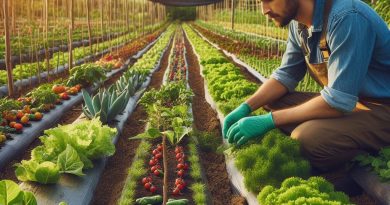Top Weed Prevention Tips for Healthy Crops
Last Updated on March 2, 2024
Introduction
Weed prevention plays a vital role in ensuring the well-being and productivity of crops on a farm. Without proper weed control measures, unwanted plants can hinder the growth and development of desired crops.
In this blog post, we will explore essential tips for weed prevention in farming that can help growers achieve healthy and bountiful harvests.
One of the primary reasons why weed prevention is crucial in farming is because weeds compete with cultivated plants for essential resources such as water, nutrients, and sunlight.
Their rapid growth and aggressive nature make them formidable adversaries to crops. In extreme cases, weeds can even overtake entire fields, causing significant yield losses.
The purpose of this blog post is to provide farmers with valuable insights and practical tips to effectively prevent weed growth and ensure the success of their crops.
By adopting proactive weed prevention measures, farmers can minimize the need for herbicides and reduce the environmental impact of farming practices.
Throughout the blog post, we will discuss various preventive strategies, such as mulching, crop rotation, and timely cultivation.
These methods not only help in weed suppression but also contribute to the overall health of the farm ecosystem.
Additionally, we will highlight the importance of early detection and proper identification of weeds to implement targeted control measures.
By following the tips and techniques outlined in this blog post, farmers can significantly improve the health and productivity of their crops while reducing the negative impacts caused by weed infestations.
Weed prevention is an integral part of sustainable farming practices and plays a crucial role in supporting food production for a growing population.
Understanding Weeds
Definition of weeds
Weeds are unwanted plants that grow vigorously, compete with crops for resources, and cause harm to agricultural production.
Weeds, those persistent invaders in our gardens, demand attention and understanding. What exactly are weeds, and why are they such a challenge?
Weeds, simply put, are unwanted plants that infiltrate cultivated areas, often outcompeting desired vegetation. These tenacious invaders have a remarkable ability to adapt, thriving in diverse environments.
Weeds not only steal nutrients from preferred plants but also hinder their growth by shading them.
Common types of weeds in agriculture
- Annual weeds: Complete their lifecycle in one year, spread fast, and produce numerous seeds.
- Perennial weeds: Can live for more than two years, spreading through both seeds and vegetative propagation.
- Grass weeds: Include species like crabgrass, quackgrass, and foxtail, known for their fast growth and ability to choke crops.
- Broadleaf weeds: Examples include dandelions, thistles, and purslane, which compete with crops for nutrients and light.
- Sedge weeds: These grass-like plants thrive in wet areas, such as rice fields, and negatively impact crop growth.
Negative impacts of weeds on crop health
- Competition for resources: Weeds absorb water, nutrients, and sunlight, diminishing available resources for crops.
- Reduced crop yield: Weeds compete with crops and limit their growth, leading to lower overall crop production.
- Pest and disease harboring: Weeds provide a sheltered environment for pests and diseases, increasing their prevalence.
- Allelopathy: Certain weeds release chemicals that hinder crop growth, affecting plant development and quality.
- Increased labor and costs: Weed management requires additional effort, time, and expenses for farmers.
In fact, weeds are more than just unwanted intruders; they are formidable adversaries that require a nuanced understanding.
By actively engaging in their identification, comprehending their life cycles, and adopting preventive measures, you empower yourself to maintain a thriving and resilient garden.
Read: Tech Advances in Crop Planting
Weed Prevention Methods
Weed prevention is crucial for maintaining healthy crops and maximizing agricultural productivity.
By implementing a combination of cultural, mechanical, and chemical methods, farmers can effectively manage weeds and minimize their impact on crop yields.
Cultural Methods
Crop rotation
Crop rotation is a technique that involves planting different crops in a specific sequence within the same field. This disrupts weed growth cycles as different crops have varying weed susceptibility.
By alternating between crops, farmers can minimize weed populations over time.
Mulching
Mulching is the practice of covering the soil around plants with a layer of organic or synthetic material. This layer acts as a barrier, preventing weed seeds from germinating and also conserving soil moisture.
Organic mulches, such as straw or wood chips, can provide additional benefits by improving soil structure and fertility.
Tillage practices
Proper tillage techniques can help control weeds by burying weed seeds deeper in the soil, preventing their germination.
However, it is important to strike a balance as excessive tillage can disrupt soil structure and increase erosion.
Conservation tillage, which minimizes soil disturbance, can be a sustainable alternative for weed control.
Mechanical Methods
Hand pulling
Hand pulling is a labor-intensive method where weeds are manually uprooted from the ground. This method is effective for small-scale weed control, but it may not be feasible for large areas.
Regular monitoring and timely removal of weeds can prevent them from spreading and competing with crops.
Mowing or cutting
Regularly mowing or cutting weeds prevents them from producing seeds and spreading. It is essential to perform this practice before weeds mature and set seed.
Proper equipment and techniques should be employed to ensure effective cutting and minimize weed re-growth.
Use of tractor-mounted weeders
Tractor-mounted weeders are mechanical devices attached to tractors that can uproot or bury weeds by using various mechanisms.
These weeders are suitable for larger farms and can efficiently remove weeds from row crops. However, it is crucial to adjust the equipment according to crop height and weed density.
Chemical Methods
Herbicides and their effectiveness
- Herbicides are chemical substances used to control unwanted plants, including weeds.
- Choosing the right herbicide and understanding its effectiveness against specific weed species is essential for successful weed management.
- Selective herbicides target specific weeds without harming crops, while non-selective herbicides kill all vegetation.
Proper herbicide application techniques
To achieve optimal results, herbicides should be applied correctly. Following label instructions regarding the dosage, timing, and application methods is crucial.
Factors like weather conditions, plant growth stage, and weed size should be considered for effective herbicide application.
Considerations for herbicide selection
- Before selecting a herbicide, farmers should assess their crops’ tolerance, potential environmental impact, and the persistence of the herbicide in the soil.
- It is important to choose herbicides that align with crop rotation plans and adopt an integrated pest management approach to minimize the risk of resistance development.
In essence, weed prevention is essential to maintain healthy crops and enhance agricultural productivity.
By employing a combination of cultural, mechanical, and chemical weed control methods, farmers can effectively manage weeds and safeguard the health and productivity of their fields.
Read: Planting for Continuous Harvest
Integrated Weed Management
Definition and concept of integrated weed management
Integrated Weed Management (IWM) is a dynamic strategy that actively addresses the complexity of weed control.
This approach involves combining various methods to create a comprehensive and effective weed management plan.
Benefits of adopting an integrated approach
- Increased crop yields: By managing weeds effectively, crops can grow without competition for nutrients and resources.
- Long-term weed control: The integration of multiple strategies helps prevent the development of herbicide-resistant weeds.
- Reduced reliance on herbicides: Integrated weed management minimizes herbicide use, leading to reduced environmental impacts.
Components of integrated weed management
- Prevention: Implementing preventive measures, such as crop rotation, to disrupt weed life cycles and reduce seed banks.
- Monitoring: Regularly observe and identify weed species to assess their population and plan suitable management strategies.
- Control measures: Applying various methods to control weeds, including mechanical cultivation, mulching, and biological control.
- Evaluation: Assess the effectiveness of the integrated weed management approach and make adjustments for continuous improvement.
In short, Integrated Weed Management is an active and evolving approach that recognizes the multifaceted nature of weed control.
By integrating preventive measures, regular monitoring, diverse control methods, and continuous evaluation, you create a robust and sustainable weed management plan.
Embrace the active principles of IWM to cultivate healthy and thriving landscapes while minimizing the impact of unwanted weeds.
Read: Crop Genetic Diversity Benefits

You Might Also Like: Eco-Friendly Pest Control in Agriculture
Best Practices for Weed Prevention
Weed prevention is a critical aspect of maintaining healthy crops and maximizing agricultural productivity.
By implementing a proactive weed prevention plan, farmers can ensure the well-being of their crops and minimize the negative impacts of weed competition.
This section highlights the best practices for effective weed prevention.
Implementing a Weed Prevention Plan
- Weed scouting and monitoring: Regularly inspect fields to identify weed species and assess their density and distribution. Early detection allows for timely action to prevent weed proliferation.
- Timely removal of weeds: Promptly remove any detected weeds to prevent them from establishing and competing with crops for essential resources such as nutrients, water, and sunlight.
- Utilizing cover crops: Planting cover crops like legumes or grasses can suppress weed growth. Cover crops act as a physical barrier, shading the soil and outcompeting weeds for resources.
Importance of Maintaining Healthy Soil
- Proper soil nutrition and pH levels: Optimizing soil fertility and pH ensures that crops receive adequate nutrients and grow vigorously. Well-nourished crops compete more effectively with weeds.
- Enhancing soil structure and drainage: Improving soil structure through practices like tillage and adding organic matter enhances water infiltration and drainage, making the soil less hospitable for weed growth.
Implementing Crop Management Techniques
- Optimal planting density and spacing: By planting crops at appropriate densities and spacings, farmers can reduce the available space for weeds to establish, limiting their growth and impact.
- Providing adequate crop nutrition: Ensuring that crops receive sufficient and balanced nutrition boosts their vigor and resilience to weed competition.
- Utilizing crop rotation strategies: Systematically rotating crops disrupt weed life cycles and deter the dominance of specific weed species by leveraging varied crop preferences.
Incorporating these best practices into a comprehensive weed prevention plan can significantly reduce the need for herbicides and reliance on mechanical weed control methods.
By actively addressing weed issues, farmers can maintain healthy crops, increase yields, and promote sustainable agricultural practices.
Ultimately, weed prevention is a continuous process that requires ongoing vigilance and management.
Regular monitoring, timely intervention, and the implementation of holistic practices can help farmers effectively prevent weed infestations and protect their crops.
By adopting these best practices, farmers can ensure the health and quality of their crops and promote efficient weed management strategies.
Read: Sustainable Crop Management 101
Conclusion
Implementing effective weed prevention strategies is essential for maintaining healthy crops and maximizing yields.
To recap, here are some key tips for weed prevention:
- Regularly monitor fields and promptly remove any weeds to prevent competition for nutrients.
- Utilize mulch or weed mats to suppress weed growth and reduce the need for manual removal.
- Practice crop rotation to disrupt weed life cycles and reduce the buildup of weed populations.
- Implement proper irrigation techniques to avoid creating ideal conditions for weed growth.
- Consider utilizing cover crops to smother weeds and improve soil health.
Proactive weed management is crucial in preserving crop yields, as weeds can significantly reduce crop productivity.
By prioritizing weed prevention, farmers can minimize the need for costly herbicides and cultivate sustainable agriculture practices.
Encouraging farmers to adopt these proactive measures is essential for the long-term health and success of the agricultural industry.
With proper weed prevention techniques, farmers can ensure the growth of robust and healthy crops while protecting the environment.


